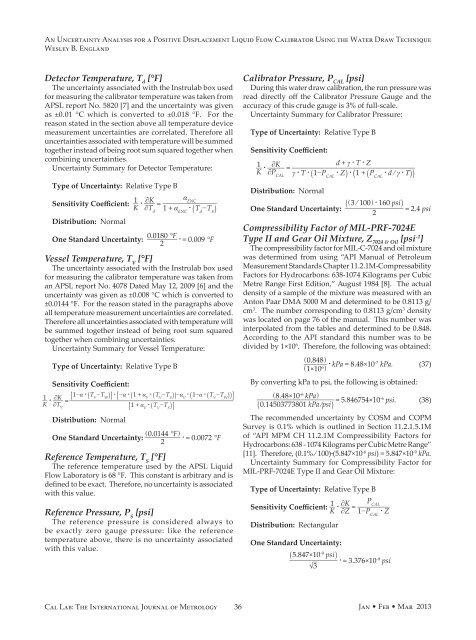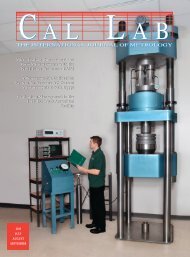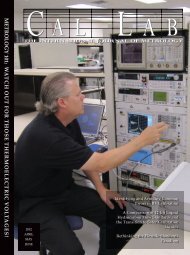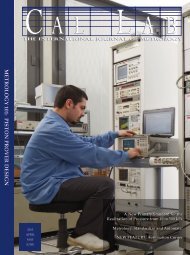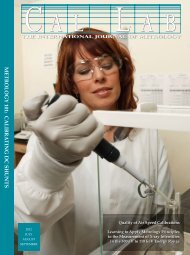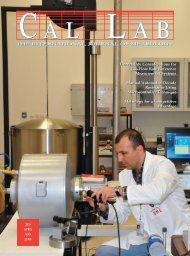Magazine – PDF - Cal Lab Magazine
Magazine – PDF - Cal Lab Magazine
Magazine – PDF - Cal Lab Magazine
You also want an ePaper? Increase the reach of your titles
YUMPU automatically turns print PDFs into web optimized ePapers that Google loves.
An Uncertainty Analysis for a Positive Displacement Liquid Flow <strong>Cal</strong>ibrator Using the Water Draw TechniqueWesley B. EnglandDetector Temperature, T d[°F]The uncertainty associated with the Instrulab box usedfor measuring the calibrator temperature was taken fromAPSL report No. 5820 [7] and the uncertainty was givenas ±0.01 °C which is converted to ±0.018 °F. For thereason stated in the section above all temperature devicemeasurement uncertainties are correlated. Therefore alluncertainties associated with temperature will be summedtogether instead of being root sum squared together whencombining uncertainties.Uncertainty Summary for Detector Temperature:Type of Uncertainty: Relative Type Bα ENCSensitivity Coefficient: 1__ K · ___ ∂K = _______________∂T d1 + α ENC· ( T d−T S ) Distribution: Normal0.0180 °FOne Standard Uncertainty: _________ · = 0.009 °F2Vessel Temperature, T V[°F]The uncertainty associated with the Instrulab box usedfor measuring the calibrator temperature was taken froman APSL report No. 4078 Dated May 12, 2009 [6] and theuncertainty was given as ±0.008 °C which is converted to±0.0144 °F. For the reason stated in the paragraphs aboveall temperature measurement uncertainties are correlated.Therefore all uncertainties associated with temperature willbe summed together instead of being root sum squaredtogether when combining uncertainties.Uncertainty Summary for Vessel Temperature:Type of Uncertainty: Relative Type BSensitivity Coefficient:1__K · ___ ∂K = [ 1−α · ( T V−T W ) ] · [ −α · ( 1 + α V· ( T V−T S ) )−α V· ( 1−α · ( T V−T_____________________________________________ W ) ) ]∂T V[ 1 + α V· ( T V−T S ) ]Distribution: NormalOne Standard Uncertainty: __________( 0.0144 °F ) · = 0.0072 °F2Reference Temperature, T S[°F]The reference temperature used by the APSL LiquidFlow <strong>Lab</strong>oratory is 68 °F. This constant is arbitrary and isdefined to be exact. Therefore, no uncertainty is associatedwith this value.Reference Pressure, P S[psi]The reference pressure is considered always tobe exactly zero gauge pressure: like the referencetemperature above, there is no uncertainty associatedwith this value.<strong>Cal</strong>ibrator Pressure, P CAL[psi]During this water draw calibration, the run pressure wasread directly off the <strong>Cal</strong>ibrator Pressure Gauge and theaccuracy of this crude gauge is 3% of full-scale.Uncertainty Summary for <strong>Cal</strong>ibrator Pressure:Type of Uncertainty: Relative Type BSensitivity Coefficient: 1__ K · _____ ∂K = __________________________________d + γ · T · Z∂P CALDistribution: Normalγ · T · ( 1−P CAL· Z ) · ( 1 + ( P CAL· d ⁄ γ · T ) ) One Standard Uncertainty: ( ( 3 ⁄ 100 )________________ · 160 psi ) = 2.4 psi2Compressibility Factor of MIL-PRF-7024EType II and Gear Oil Mixture, Z 7024 & Oil[psi -1 ]The compressibility factor for MIL-C-7024 and oil mixturewas determined from using “API Manual of PetroleumMeasurement Standards Chapter 11.2.1M-CompressabilityFactors for Hydrocarbons: 638-1074 Kilograms per CubicMetre Range First Edition,” August 1984 [8]. The actualdensity of a sample of the mixture was measured with anAnton Paar DMA 5000 M and determined to be 0.8113 g/cm 3 . The number corresponding to 0.8113 g/cm 3 densitywas located on page 76 of the manual. This number wasinterpolated from the tables and determined to be 0.848.According to the API standard this number was to bedivided by 1×10 6 . Therefore, the following was obtained:( 0.848 ) _______( 1×10 6 ) · kPa = 8.48×10-7 kPa. (37)By converting kPa to psi, the following is obtained:_____________________( 8.48×10-6 kPa )( 0.14503773801 kPa ⁄psi ) = 5.846754×10-6 psi. (38)The recommended uncertainty by COSM and COPMSurvey is 0.1% which is outlined in Section 11.2.1.5.1Mof “API MPM CH 11.2.1M Compressibility Factors forHydrocarbons: 638 - 1074 Kilograms per Cubic Metre Range”[11]. Therefore, (0.1% ⁄ 100)·(5.847×10 -6 psi) = 5.847×10 -9 kPa.Uncertainty Summary for Compressibility Factor forMIL-PRF-7024E Type II and Gear Oil Mixture:Type of Uncertainty: Relative Type BP CALSensitivity Coefficient: 1__ K · ___ ∂K∂Z = _________1−P CAL· Z Distribution: RectangularOne Standard Uncertainty:_____________ ( 5.847×10-9 psi )√ · = 3.376×10 -9 psi3 <strong>Cal</strong> <strong>Lab</strong>: The International Journal of Metrology36 Jan • Feb • Mar 2013


